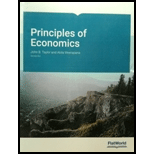Solutions for Principles Of Economics V8.0
Problem 1SCQ:
Answer these three questions about early-stage corporate finance: Why do very small companies tend...Problem 2SCQ:
From a firms point of view, how is a bond similar to a bank loan? How are they different?Problem 3SCQ:
Calculate the equity each of these people has in his or her home: Fred just bought a house for...Problem 4SCQ:
Which has a higher average return over time: stocks, bands, or a savings account? Explain your...Problem 5SCQ:
Investors sometimes fear that a high-risk investment is especially likely to have low returns. Is...Problem 6SCQ:
What is the total amount of interest from a 5,000 loan after three years with a simple interest rate...Problem 7SCQ:
If you receive 500 in simple interest on a loan that you made for 10,000 for five years, what was...Problem 8SCQ:
You open a 5-year CD for 1,000 that pays 2 interest, compounded annually. What is the value of that...Problem 10RQ:
Why can firms not just use their own profits for financial capital, with no need for outside...Problem 12RQ:
What is a bond?Problem 13RQ:
What does a share of stock represent?Problem 14RQ:
When do firms receive money from a stock sale in their firm and when do they not receive money?Problem 15RQ:
What is a dividend?Problem 16RQ:
What is a capital gain?Problem 19RQ:
Why are banks called financial intermediaries?Problem 21RQ:
Why are bonds somewhat risky to buy, even though they make predetermined payments based on a fixed...Problem 23RQ:
What is a mutual fund?Problem 24RQ:
What is an index fund?Problem 27RQ:
What are the two key choices U.S. citizens need to make that determines their relative wealth?Problem 28RQ:
Is investing in housing always a very safe investment?Problem 29CTQ:
If you owned a small firm that had become somewhat established, but you needed a surge of financial...Problem 31CTQ:
What are some reasons why the investment strategy of a 30-year-old might differ flow the investment...Problem 32CTQ:
Explain why a financial investor in stocks cannot earn high capital gains simply by buying companies...Problem 33CTQ:
Explain what happens in an economy when the financial markets limit access to capital. How does this...Problem 34CTQ:
You and your friend have opened an account on E-Trade and have each decided to select five similar...Problem 35CTQ:
How do bank failures cause the economy to go into recession?Problem 36P:
The Darkroom Windowshade Company has 100,000 shares of stock outstanding. The investors in the firm...Problem 37P:
Imagine that a local water company issued 10,000 ten-year bond at an interest rate of 6. You are...Problem 38P:
Suppose Ford Motor Company issues a five year bond with a face value of 5,000 that pays an annual...Browse All Chapters of This Textbook
Chapter 1 - Welcome To Economics!Chapter 2 - Choice In A World Of ScarcityChapter 3 - Demand And SupplyChapter 4 - Labor And Financial MarketsChapter 5 - ElasticityChapter 6 - Consumer ChoicesChapter 7 - Production, Costs, And Industry StructureChapter 8 - Perfect CompetitionChapter 9 - MonopolyChapter 10 - Monopolistic Competition And Oligopoly
Chapter 11 - Monopoly And Antitrust PolicyChapter 12 - Environmental Protection And Negative ExternalitiesChapter 13 - Positive Externalities And Public GoodsChapter 14 - Labor Markets And IncomeChapter 15 - Poverty And Economic InequalityChapter 16 - Information, Risk, And InsuranceChapter 17 - Financial MarketsChapter 18 - Public EconomyChapter 19 - The Macroeconomic PerspectiveChapter 20 - Economic GrowthChapter 21 - UnemploymentChapter 22 - InflationChapter 23 - The International Trade And Capital FlowsChapter 24 - The Aggregate Demand/aggregate Supply ModelChapter 25 - The Keynesian PerspectiveChapter 26 - The Neoclassical PerspectiveChapter 27 - Money And BankingChapter 28 - Monetary Policy And Bank RegulationChapter 29 - Exchange Rates And International Capital FlowsChapter 30 - Government Budgets And Fiscal PolicyChapter 31 - The Impacts Of Government BorrowingChapter 32 - Macroeconomic Policy Around The WorldChapter 33 - International TradeChapter 34 - Globalization And ProtectionismChapter A - The Use Of Mathematics In Principles Of EconomicsChapter B - Indifference CurvesChapter D - The Expenditure-output Model
Sample Solutions for this Textbook
We offer sample solutions for Principles Of Economics V8.0 homework problems. See examples below:
Chapter 1, Problem 1SCQChapter 2, Problem 1SCQChapter 3, Problem 1SCQChapter 4, Problem 1SCQChapter 5, Problem 1SCQChapter 6, Problem 1SCQChapter 7, Problem 1SCQChapter 8, Problem 1SCQChapter 9, Problem 1SCQ
Chapter 10, Problem 1SCQChapter 11, Problem 1SCQChapter 12, Problem 1SCQChapter 13, Problem 1SCQChapter 14, Problem 1SCQChapter 15, Problem 1SCQChapter 16, Problem 1SCQChapter 17, Problem 1SCQChapter 18, Problem 1SCQChapter 19, Problem 1SCQChapter 20, Problem 1SCQChapter 21, Problem 1SCQChapter 22, Problem 1SCQChapter 23, Problem 1SCQChapter 24, Problem 1SCQChapter 25, Problem 1SCQChapter 26, Problem 1SCQChapter 27, Problem 1SCQChapter 28, Problem 1SCQChapter 29, Problem 1SCQChapter 30, Problem 1SCQChapter 31, Problem 1SCQChapter 32, Problem 1SCQChapter 33, Problem 1SCQChapter 34, Problem 1SCQChapter A, Problem 1RQChapter B, Problem 1RQChapter D, Problem 6RQ
More Editions of This Book
Corresponding editions of this textbook are also available below:
Principles of Economics 2e
2nd Edition
ISBN: 9781947172364
Principles Of Economics 2e
2nd Edition
ISBN: 9781680920864
PRINCIPLES OF ECONOMICS (OER)
2nd Edition
ISBN: 9781947172371
PRINCIPLES OF ECONOMICS
14th Edition
ISBN: 2810015433483
PRINCIPLES OF ECONOMICS (OER)
19th Edition
ISBN: 9781506698137
Prin.of Economics
4th Edition
ISBN: 9780996996310
PRIN.OF ECONOMICS (B+W,PB)
5th Edition
ISBN: 9780996095419
PRIN.OF ECONOMICS (COLOR,PB)
5th Edition
ISBN: 9781930789968
PRINCIPLES OF ECONOMICS FLATWORLD
9th Edition
ISBN: 9781453339176
Principles of Economics
16th Edition
ISBN: 9781938168239
PRIN.OF ECONOMICS
7th Edition
ISBN: 9780538453592
PRINCIPLES OF ECONOMICS (OER)>CUSTOM<
18th Edition
ISBN: 9781947172289
Related Economics Textbooks with Solutions
Still sussing out bartleby
Check out a sample textbook solution.
